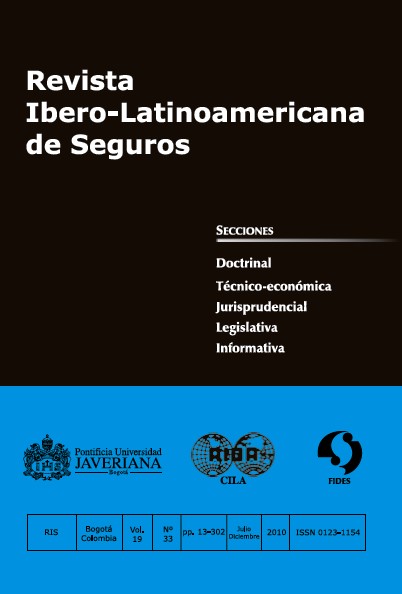Resumen
El presente artículo recoge las ideas expuestas por HERFIELD SCHLUDE en relación con las reglas de solvencia para las compañías de seguros no-vida de la entonces Comunidad Económica Europea, EEC, por sus siglas en inglés. SCHLUDE hace un recuento general del origen del margen de solvencia y relaciona la forma en que se escogieron los indicadores de primas y siniestros, la determinación del monto del citado margen y la forma en que se tuvo en cuenta la influencia del reaseguro. SCHLUDE muestra igualmente las ventajas y desventajas del sistema que se estableció en 1978.
El artículo tiene una relevancia especial para el mercado asegurador colombiano porque en la actualidad se utiliza casi el mismo sistema y le son aplicables tanto las ventajas como las desventajas del mismo y, en especial, porque la Superintendencia Financiera de Colombia ha realizado modificaciones al margen, agregando requerimiento de capital para los riesgos de crédito y de mercado, sin hacer modificación alguna al riesgo de suscripción, único riesgo que tiene en cuenta la metodología vigente.
Esta revista científica se encuentra registrada bajo la licencia Creative Commons Reconocimiento 4.0 Internacional. Por lo tanto, esta obra se puede reproducir, distribuir y comunicar públicamente en formato digital, siempre que se reconozca el nombre de los autores y a la Pontificia Universidad Javeriana. Se permite citar, adaptar, transformar, autoarchivar, republicar y crear a partir del material, para cualquier finalidad (incluso comercial), siempre que se reconozca adecuadamente la autoría, se proporcione un enlace a la obra original y se indique si se han realizado cambios. La Pontificia Universidad Javeriana no retiene los derechos sobre las obras publicadas y los contenidos son responsabilidad exclusiva de los autores, quienes conservan sus derechos morales, intelectuales, de privacidad y publicidad.
El aval sobre la intervención de la obra (revisión, corrección de estilo, traducción, diagramación) y su posterior divulgación se otorga mediante una licencia de uso y no a través de una cesión de derechos, lo que representa que la revista y la Pontificia Universidad Javeriana se eximen de cualquier responsabilidad que se pueda derivar de una mala práctica ética por parte de los autores. En consecuencia de la protección brindada por la licencia de uso, la revista no se encuentra en la obligación de publicar retractaciones o modificar la información ya publicada, a no ser que la errata surja del proceso de gestión editorial. La publicación de contenidos en esta revista no representa regalías para los contribuyentes.


